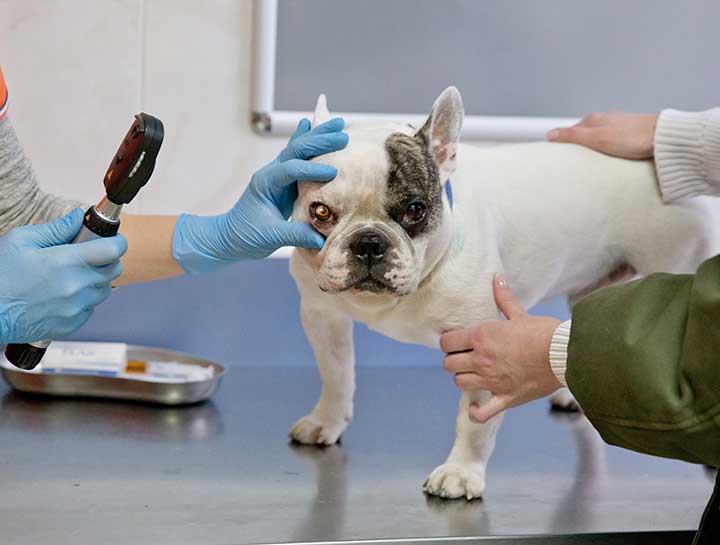Ophthalmology
Minor to severe eye care for pets
Common Eye Conditions
- KCS (keratoconjunctivitis sicca) or dry eye
- Glaucoma
- Eye Ulcers
- Conjunctivitis
KCS (keratoconjunctivitis sicca) Management
Dry eye, also known as KCS (keratoconjunctivitis sicca) is a common eye condition that can affect both cats and dogs. It occurs when there is a lack of tear production or when the quality of tears is poor, leading to discomfort and potential damage to the eyes.
Some signs of KCS (keratoconjunctivitis sicca) to look out for in your furry companion include:
- excessive blinking
- redness in the eyes
- thick discharge
- squinting
- corneal ulcers
If you suspect that your pet may be suffering from dry eye, it is essential to seek veterinary care promptly.
How is KCS (keratoconjunctivitis sicca) diagnosed?
During the examination, the veterinarian will assess the signs and symptoms of dry eye the Schirmer tear test is typically conducted to confirm the diagnosis of KCS (keratoconjunctivitis sicca). The Schirmer tear test is used to measure the production of tears in the eye. It helps determine if a pet is producing enough tears to keep their eyes moist and healthy. During the test, small strips of blotting paper are placed under the lower eyelids to absorb tears over a certain period. The amount of tears absorbed by the paper is then measured to assess the quantity of tears produced.
How is KCS (keratoconjunctivitis sicca) treated?
Treatment options may include artificial tear supplements, medications to stimulate tear production, and in severe cases, surgery.
Regular veterinary check-ups and proactive eye care can help prevent complications and ensure that your pet's eyes remain healthy and comfortable. Remember, keeping an eye out for any changes in your pet's eye health and seeking professional help when needed can make a significant difference in their overall well-being.
Schedule your pet’s appointment today if you thin they need an eye exam.
Glaucoma Management
Glaucoma is a common condition in which the fluid pressure inside the eye increases, resulting in damage to the optic nerve, followed by loss of vision and blindness. There are two types of glaucoma. Primary, or chronic, glaucoma is hereditary or develops as your pet ages. Secondary, or acute, glaucoma develops as the result of an injury or illness. Because secondary glaucoma can progress rapidly, it is considered an emergency situation.
Symptoms of glaucoma to look for include:
- Redness in the eye
- Tearing or discharge
- Eye sensitivity to light
- Pain
- Cloudy-looking eye
- Bulging eyeball
At Creekside Animal Hospital, we recommend that your pet receive a routine glaucoma exam as part of his or her regular wellness care. The exam is not only an effective screening measure for chronic and acute glaucoma, but it can also help set a baseline measurement of your pet's normal intraocular pressure (IOP). Establishing an IOP baseline is important because the normal measurement can vary between species, breeds, and even individual pets.
This is a noninvasive, simple procedure that should not cause your pet any pain or discomfort. We apply a mild anesthetic eye drop to ensure your pet is comfortable during the exam.
Call us at (281) 351-8387 if you think your pet needs an eye exam.
Eye Ulcers
Eye ulcers in cats and dogs can be a cause of concern for pet owners. These ulcers are typically characterized by a painful sore on the surface of the eye that can lead to discomfort and potential vision problems for our furry friends. It is essential to seek veterinary care if you suspect your pet may have an eye ulcer, as prompt treatment is crucial for their eye health and overall well-being.
Common causes of eye ulcers in cats and dogs include:
- injuries
-
foreign objects in the eye
-
infections
-
underlying health conditions.
Symptoms of eye ulcers may include:
- squinting
- excessive tearing
- redness, cloudiness in the eye
- pawing at the affected eye
If you notice any of these signs, it is important to consult with a veterinarian for a proper diagnosis and treatment plan.
Treatment for eye ulcers in pets may involve:
- medicated eye drops or ointments
- oral medications
- surgery (in severe cases)
How are eye ulcers in cats and dogs diagnosed?
Eye ulcers in cats and dogs can be diagnosed through a series of examinations by a veterinarian. One common method is through a thorough eye examination using a special dye called fluorescein. This dye helps to highlight any abnormalities or ulcers on the surface of the eye. In some cases, additional tests such as eye pressure measurements or swabs to check for underlying infections may be necessary to determine the cause of the ulcer. It's crucial to seek veterinary care if you suspect your pet may have an eye ulcer to ensure proper diagnosis and treatment.
Your veterinarian will determine the best course of action based on the underlying cause and severity of the ulcer. Additionally, it is crucial to follow your veterinarian's instructions carefully and attend follow-up appointments to monitor your pet's progress.
Preventing eye ulcers in cats and dogs involves keeping their environment safe, avoiding potential eye irritants, and addressing any underlying health issues promptly. Regular veterinary check-ups can also help detect any potential eye problems early on. By being proactive about your pet's eye health, you can help keep their eyes bright, healthy, and free from ulcers.
Regular veterinary check-ups and proactive eye care can help prevent complications and ensure that your pet's eyes remain healthy and comfortable. Remember, keeping an eye out for any changes in your pet's eye health and seeking professional help when needed can make a significant difference in their overall well-being.
Schedule your pet’s appointment today!
Conjunctivitis
Conjunctivitis in cats and dogs is a common eye condition that can cause redness, discharge, and discomfort. Conjunctivitis, commonly known as pink eye, is an eye condition that involves inflammation of the thin, clear tissue that covers the white part of the eye and lines the inner surface of the eyelid including the third eyelid. This can be caused by viruses, bacteria, allergens, or irritants.
Symptoms of conjunctivitis may include:
- redness
- itching
- excessive tearing
- discharge that can cause the eyelids to stick together.
If you suspect your pet may have conjunctivitis, it is best to consult with a veterinarian for proper diagnosis and treatment. Treatment may include eye drops, ointments, or medications to help alleviate symptoms and prevent any complications. Remember to always provide gentle care and comfort to your furry friend during their recovery from conjunctivitis.
Schedule your pet’s appointment today!

